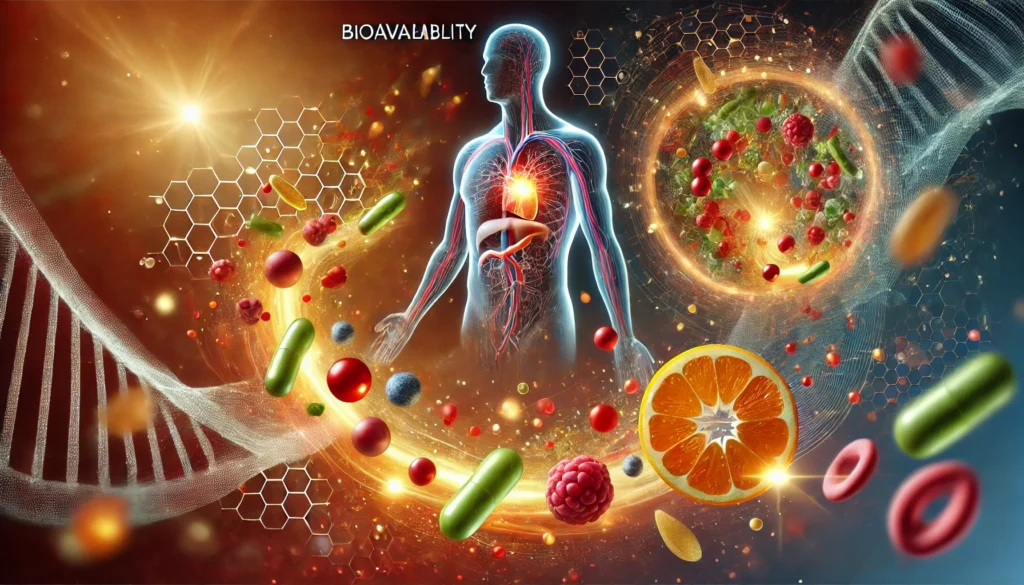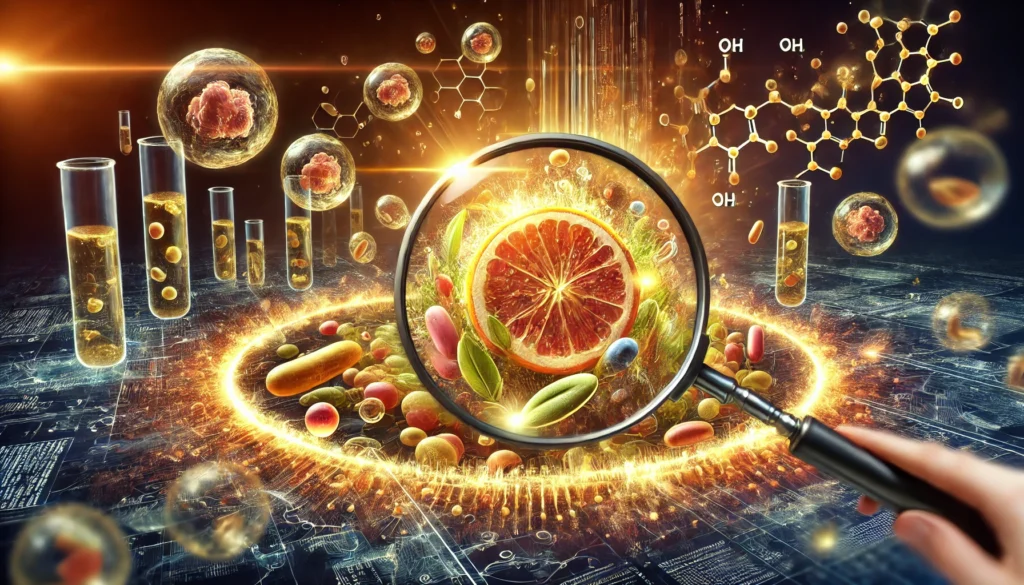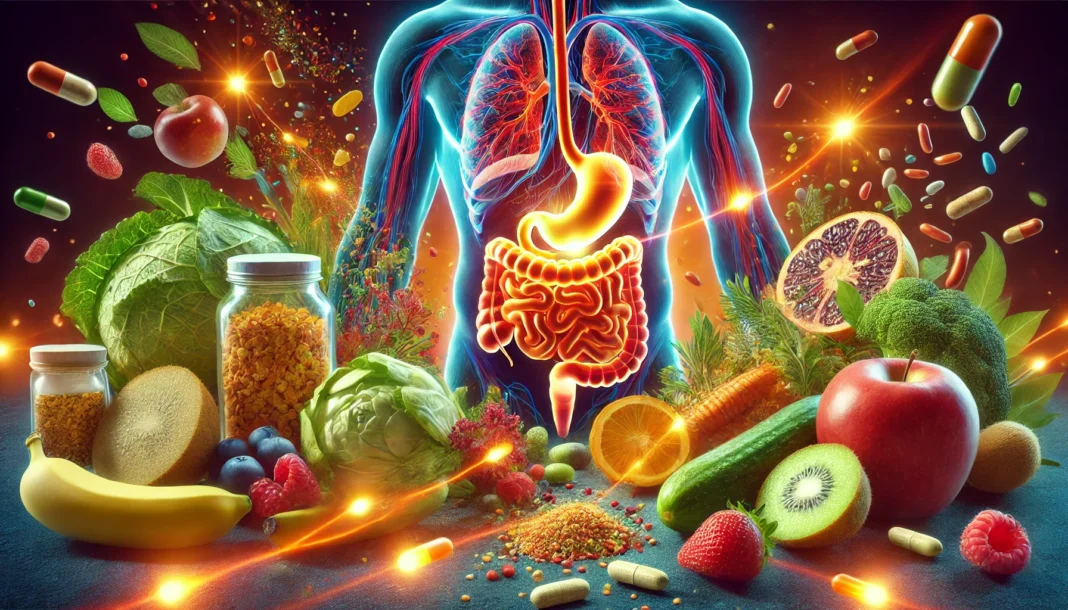Introduction: The Importance of Bioavailability in Nutrition
Bioavailability is a critical concept in nutrition and holistic health, yet it remains largely misunderstood by the general public. Many individuals consume supplements and nutrient-dense foods with the expectation that their bodies will fully absorb and utilize the nutrients provided. However, the extent to which these nutrients are actually absorbed into the bloodstream and made available for cellular function depends on their bioavailability. Understanding what bioavailability is, how it affects nutrient absorption, and the factors that enhance or inhibit it is essential for optimizing health outcomes.
You may also like: What Is Bioavailability in Nutrition? A Simple Explanation of How Nutrients Are Absorbed and Utilized
This article explores the meaning of bioavailability, its role in nutrient absorption, and the various biological and external factors that influence it. By the end of this discussion, readers will have a clear understanding of how to maximize the bioavailability of essential nutrients through dietary choices, supplementation strategies, and lifestyle modifications.

Defining Bioavailability: A Simple Explanation
To define bioavailability in simple terms, it refers to the proportion of a nutrient that is absorbed and utilized by the body. The term is commonly used in pharmacology and nutrition to describe the efficiency with which a substance enters the bloodstream and reaches its intended site of action. A nutrient with high bioavailability is readily absorbed and effectively used, while one with low bioavailability may be poorly absorbed, metabolized, or excreted before it can exert its beneficial effects.
When discussing the meaning of bioavailable nutrients, it is important to recognize that not all nutrients are equally accessible to the body. Factors such as digestive health, food composition, chemical form, and interactions with other compounds can significantly alter bioavailability. For example, certain vitamins and minerals require co-factors to enhance their absorption, while others may be inhibited by dietary components such as fiber or phytates.
How Does Bioavailability Affect Nutrient Absorption?
The process of nutrient absorption begins in the digestive system, where food is broken down into its component parts. However, just because a nutrient is present in a food or supplement does not mean it will be absorbed efficiently. Bioavailability determines how much of a nutrient actually enters the bloodstream and becomes available for use by tissues and organs.
For instance, consider the case of iron. There are two main types of dietary iron: heme iron, found in animal sources such as red meat, and non-heme iron, found in plant-based foods like spinach. Heme iron has higher bioavailability, meaning it is more readily absorbed by the body, whereas non-heme iron has lower bioavailability and requires the presence of vitamin C to enhance absorption. This example illustrates how bioavailability directly influences nutrient absorption and, consequently, overall health.
Factors Influencing Bioavailability
Several key factors affect the bioavailability of nutrients, including digestion efficiency, molecular structure, nutrient interactions, and individual health conditions. Understanding these factors can help individuals make informed dietary choices to optimize their nutrient intake.
1. Digestive Health and Enzyme Activity A well-functioning digestive system is crucial for nutrient absorption. The stomach produces gastric acid and digestive enzymes that break down food into absorbable forms. Individuals with low stomach acid or enzyme deficiencies may struggle to absorb certain nutrients, such as vitamin B12, which requires intrinsic factor for absorption. Conditions like irritable bowel syndrome (IBS) or celiac disease can further impair nutrient uptake by damaging the intestinal lining.
2. Nutrient Interactions and Synergy The presence of other nutrients can either enhance or inhibit bioavailability. For example, calcium competes with iron for absorption, meaning that consuming high doses of calcium alongside iron-rich foods may reduce iron bioavailability. Conversely, vitamin D enhances calcium absorption by promoting its transport across the intestinal lining. These interactions highlight the importance of balanced nutrition.
3. Chemical Form and Solubility The form in which a nutrient is consumed affects its absorption. Some nutrients, like fat-soluble vitamins (A, D, E, and K), require dietary fats for optimal uptake, whereas water-soluble vitamins (C and B-complex) dissolve in water and are absorbed differently. Certain minerals, such as magnesium, are more bioavailable in citrate or glycinate forms compared to oxide forms, which have lower absorption rates.
Strategies to Enhance Nutrient Bioavailability
Maximizing nutrient bioavailability involves choosing the right food combinations, optimizing digestive function, and selecting high-quality supplements when necessary. Here are some practical strategies:
1. Pairing Nutrients for Optimal Absorption Consuming foods that naturally enhance bioavailability can significantly improve nutrient uptake. For instance, pairing iron-rich plant foods with vitamin C sources (such as citrus fruits) enhances iron absorption. Similarly, including healthy fats like avocado or olive oil in meals can aid in the absorption of fat-soluble vitamins.
2. Choosing Whole, Minimally Processed Foods Whole foods generally contain bioavailable nutrients in their natural matrix, which supports absorption. Highly processed foods may contain synthetic additives that hinder bioavailability, such as artificial preservatives that interfere with digestive enzymes. Prioritizing organic, whole foods can improve nutrient absorption.
3. Supporting Gut Health A healthy gut microbiome plays a significant role in nutrient absorption. Probiotic-rich foods like yogurt, kimchi, and sauerkraut can enhance digestion, while prebiotic fibers found in garlic, onions, and bananas nourish beneficial gut bacteria. Maintaining gut health ensures that nutrients are efficiently absorbed and utilized.

Frequently Asked Questions (FAQ) on Bioavailability and Absorption
1. What does bioavailability mean, and why is it important?
Bioavailability refers to the proportion of a substance that enters the bloodstream and is available for use by the body. It plays a crucial role in determining how effectively nutrients, medications, and other compounds perform their intended function. For example, even if a supplement contains a high dose of a nutrient, its effectiveness depends on how much of it is actually absorbed. Understanding the definition of bioavailable nutrients helps consumers choose the most efficient formulations, ensuring they receive the intended benefits. The meaning of bioavailable absorption can also influence dietary choices, supplementation strategies, and even the development of pharmaceutical drugs.
2. How does bioavailability affect absorption?
Bioavailability directly impacts the efficiency of nutrient and drug absorption. A substance with high bioavailability is more readily absorbed and utilized by the body, whereas one with low bioavailability may pass through the digestive system without significant uptake. Factors such as digestive health, enzyme activity, and co-nutrient presence can alter bioavailability, making some compounds more effective when taken with specific foods or in a particular form. For example, the absorption of fat-soluble vitamins improves when consumed with dietary fats. By understanding how bioavailability affects absorption, individuals can make better-informed decisions regarding their diets and supplement regimens.
3. Can bioavailability be enhanced naturally?
Yes, several natural methods can enhance bioavailability and improve the body’s ability to absorb nutrients efficiently. Pairing certain foods together is one effective strategy; for example, consuming vitamin C-rich foods alongside plant-based iron sources enhances iron absorption. Additionally, fermentation and sprouting can break down antinutrients in foods, making their minerals more bioavailable. Cooking techniques, such as lightly steaming vegetables instead of boiling them, can also preserve their nutrient content. Learning how to define bioavailability in a practical sense allows individuals to maximize their nutrient intake without relying solely on supplements.
4. What factors influence the bioavailability of vitamins and minerals?
Several factors influence the bioavailability of nutrients, including their chemical form, the presence of co-factors, and individual digestive efficiency. For instance, magnesium citrate has higher bioavailability compared to magnesium oxide, making it a preferred supplement choice. Gut health also plays a significant role—conditions like leaky gut or inflammation can hinder nutrient absorption. Additionally, interactions between nutrients, such as calcium and iron competing for absorption, highlight the complexity of bioavailability. By understanding the meaning of bioavailable compounds, individuals can optimize their diet and supplement choices for better health outcomes.
5. How does bioavailability apply to pharmaceuticals?
In pharmaceuticals, bioavailability determines how much of a drug reaches systemic circulation and exerts therapeutic effects. Different drug formulations can have varying bioavailability depending on factors like solubility, stability, and metabolism. For example, some medications are designed with enteric coatings to protect them from stomach acid, ensuring they reach the intestines where absorption is more efficient. Understanding the simple definition of bioavailability helps both patients and healthcare providers select the most effective treatment options. This knowledge is also crucial in drug development, where researchers aim to create formulations with optimal bioavailability for maximum efficacy.
6. Are liquid supplements more bioavailable than pills?
In many cases, liquid supplements have higher bioavailability compared to pills or capsules because they bypass some digestive processes that may reduce absorption. Liquids are often absorbed more quickly and do not require breakdown in the stomach, making them ideal for individuals with compromised digestion. However, not all liquid formulations guarantee superior bioavailability—certain compounds may require encapsulation or specific carriers to enhance absorption. By exploring different forms of vitamin and mineral delivery, consumers can determine which provides the highest definition of bioavailable benefits. Consulting with healthcare professionals can also help in choosing the best supplement format.
7. How do lifestyle choices impact bioavailability?
Lifestyle choices such as diet, hydration, and physical activity can all affect bioavailability. For example, dehydration can hinder digestion and reduce the efficiency of nutrient absorption. A diet rich in whole, unprocessed foods provides the necessary co-factors for enhancing bioavailability, whereas processed foods may contain inhibitors that block nutrient uptake. Exercise also improves circulation and metabolism, potentially enhancing the absorption of certain nutrients. Defining bioavailability beyond just nutrient content involves recognizing how external factors contribute to overall health and efficiency in nutrient utilization. Making small but meaningful changes to daily habits can significantly impact bioavailability.
8. What is the difference between absolute and relative bioavailability?
Absolute bioavailability refers to the percentage of a substance that reaches systemic circulation compared to an intravenous dose, which has 100% bioavailability. Relative bioavailability, on the other hand, compares the absorption of one formulation to another under similar conditions. For example, a new formulation of a medication may be tested against an existing version to determine if it has improved bioavailability. These distinctions are critical in both pharmaceutical research and nutritional sciences. Understanding how bioavailability affects absorption in different contexts helps consumers and healthcare professionals evaluate the effectiveness of various formulations.
9. How does aging affect bioavailability?
As individuals age, bioavailability can decrease due to physiological changes such as reduced enzyme production, slower metabolism, and diminished digestive efficiency. Older adults may require higher doses of certain nutrients to compensate for lower absorption rates. Additionally, medications commonly used by older populations can interfere with nutrient uptake, further complicating bioavailability. Strategies such as consuming nutrient-dense foods, staying hydrated, and supplementing wisely can help mitigate these effects. Recognizing that bioavailability is a dynamic process allows aging individuals to take proactive steps to maintain optimal nutrient levels.
10. Can bioavailability be measured?
Yes, bioavailability can be measured using various scientific methods, including blood plasma concentration tests and absorption rate studies. These methods help researchers determine how much of a nutrient or drug is available for use in the body over time. Clinical trials often compare different formulations to assess which offers superior bioavailability. In nutrition, studies analyzing urine and blood markers help evaluate how efficiently nutrients are absorbed and utilized. By defining bioavailability through research and practical application, scientists continue to refine formulations that enhance health and therapeutic outcomes.

Conclusion: Applying Bioavailability Principles for Better Health
Understanding what bioavailability means and how it affects nutrient absorption allows individuals to make informed dietary choices that optimize their health. By focusing on factors such as food pairing, digestive health, and nutrient interactions, individuals can enhance their nutrient intake and ensure that their bodies receive the full benefit of the foods and supplements they consume. Bioavailability is not just a theoretical concept—it has real-world implications for improving overall well-being and achieving optimal nutrition.
By implementing strategies to improve bioavailability, such as consuming nutrient-dense whole foods, enhancing digestive function, and making mindful supplement choices, individuals can take control of their health in meaningful ways. Ultimately, an awareness of bioavailability empowers people to maximize the benefits of their diet and supplementation, leading to improved energy levels, better immune function, and long-term wellness.
nutrient absorption, how does bioavailability affect absorption, define bioavailability simple definition, meaning of bioavailable, holistic supplements, bioavailable nutrients, food synergy, gut health and absorption, vitamin bioavailability, mineral absorption, nutrient uptake, digestion and bioavailability, supplement absorption, fat-soluble vitamins, water-soluble vitamins, digestive enzymes, gut microbiome and nutrition, enhancing bioavailability naturally, whole foods and nutrient absorption, healthy digestion, optimizing nutrient intake
Further Reading:
Factors affecting drug absorption and distribution
The Bioavailability of Drugs—The Current State of Knowledge
Disclaimer
The information contained in this article is provided for general informational purposes only and is not intended to serve as medical, legal, or professional advice. While NewsHealthWatch strives to present accurate, up-to-date, and reliable content, no warranty or guarantee, expressed or implied, is made regarding the completeness, accuracy, or adequacy of the information provided. Readers are strongly advised to seek the guidance of a qualified healthcare provider or other relevant professionals before acting on any information contained in this article. NewsHealthWatch, its authors, editors, and contributors expressly disclaim any liability for any damages, losses, or consequences arising directly or indirectly from the use, interpretation, or reliance on any information presented herein. The views and opinions expressed in this article are those of the author(s) and do not necessarily reflect the official policies or positions of NewsHealthWatch.

